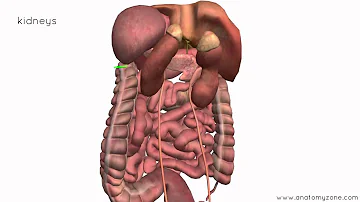What does it mean if an organ is intraperitoneal?
Within the peritoneal cavityperitoneal cavityThe space within the abdomen that contains the intestines, the stomach, and the liver.https://www.cancer.gov › cancer-terms › def › peritoneal-cavityDefinition of peritoneal cavity – NCI Dictionary of Cancer Terms (the area that contains the abdominal organs).
What is the difference between intraperitoneal and retroperitoneal organs?
Intraperitoneal: peritonealized organs having a mesentery, such as the stomach, small intestine (jejunum and ileum), transverse colon, liver and gallbladder. Retroperitoneal: organs without a mesentery and associated with posterior body wall, such as the aorta, inferior vena cava, kidneys and suprarenal glands.

What are the characteristics of intraperitoneal?
Intraperitoneal structures
Characteristics: (Largely) surrounded by peritoneum. Directly visible and accessible after opening the peritoneal cavity (and moving the greater omentum aside) Mobile (most)
How do you remember which organs are intraperitoneal?
Mnemonic
- S: stomach.
- A: appendix.
- L: liver.
- T: transverse colon.
- D: duodenum (first part)
- S: small intestines (jejunum and ileum)
- P: pancreas (only tail)
- R: rectum (upper third)
What is the meaning of retroperitoneal organs?
The area in the back of the abdomen behind the peritoneum (the tissue that lines the abdominal wall and covers most of the organs in the abdomen). The organs in the retroperitoneum include the adrenal glands, aorta, kidneys, esophagus, ureters, pancreas, rectum, and parts of the stomach and colon.
Why do we use intraperitoneal?
Intraperitoneal administration allows quick reabsorption of large volumes of substances and is the preferred injection route for nonirritant, isotonic solutions [7,11].
Where are intraperitoneal organs located?
Intraperitoneal Structures
Intraperitoneal organs include the stomach, the first five centimeters and the fourth part of the the duodenum, the jejunum, the ileum, the cecum, the appendix, the transverse colon, the sigmoid colon, and the upper third of the rectum.
What is the advantage of intraperitoneal?
The benefit of administering drugs intraperitoneally is the ability for the peritoneal cavity to absorb large amounts of a drug quickly.
Is Kidney an intraperitoneal organ?
The kidneys are bean-shaped organs located in the upper retroperitoneal region of the abdomen. That is, they are located behind the smooth peritoneal lining of the upper part of the abdominal cavity, between it and the posterior body wall. Therefore, they are actually outside the peritoneal cavity.
Why are kidneys called retroperitoneal?
The kidneys are considered “retroperitoneal” organs, which means they sit behind a lining in the abdominal cavity, unlike all other abdominal organs.
Is the pancreas intraperitoneal or retroperitoneal?
The pancreas is a retroperitoneal organ with a close anatomic relationship to the peritoneal reflections in the abdomen, including the transverse mesocolon and the small bowel mesentery, and is directly contiguous to peritoneal ligaments such as the hepatoduodenal ligament, gastrohepatic ligament, splenorenal ligament, …
Is the bladder an intraperitoneal organ?
The bladder is a subperitoneal, hollow muscular organ that acts as a reservoir for urine. The bladder is located in the lesser pelvis when empty and extends into the abdominal cavity when full.
Is intraperitoneal the same as intra abdominal?
The abdominal cavity (the space bounded by the vertebrae, abdominal muscles, diaphragm, and pelvic floor) is different from the intraperitoneal space (located within the abdominal cavity but wrapped in peritoneum).
What is the disadvantage of intraperitoneal?
The main disadvantage of this route is that it is minimally used in clinic (mostly for treatment of peritoneal cancers), because of which its use in experimental studies is often questioned and discouraged.
Why is uterus intraperitoneal?
The body of the uterus is surrounded by peritoneum, hence it lies intraperitoneal.
Is uterus intraperitoneal?
The body of the uterus is surrounded by peritoneum, hence it lies intraperitoneal. The first part of the rectum lies posterior to the peritoneum, hence it is retroperitoneal.
How do organs become retroperitoneal?
Organs are retroperitoneal if they have peritoneum on their anterior side only. Structures that are not suspended by mesentery in the abdominal cavity and that lie between the parietal peritoneum and abdominal wall are classified as retroperitoneal.
What organ is primarily retroperitoneal?
- The primary retroperitoneal structures are the adrenal glands, kidneys, ureters, inferior vena cava, and the rectum. Secondary retroperitoneal structures include the duodenum (except for the proximal first segment), the pancreas (head, neck and body), ascending colon, and descending colon.
Which organ is most likely intraperitoneal?
Intraperitoneal organs include the stomach, spleen, liver, first and fourth parts of the duodenum, jejunum, ileum, transverse, and sigmoid colon.
Are kidneys intraperitoneal organs?
- The kidneys are considered “retroperitoneal” organs, which means they sit behind a lining in the abdominal cavity, unlike all other abdominal organs.
Why is ovary intraperitoneal?
Of all intraperitoneal organs, the ovary is the only one that is not delineated by peritoneum of the free abdominal cavity. Thus, during ovulation, the mature egg reaches the free abdominal space before getting swept in by the ciliated epithelium of the oviduct, arching over the ovary.
Are ovaries intra or retroperitoneal?
Although the ovary is considered an intraperitonal organ, it only has a peritoneal duplicate but its surface isn't covered by peritoneum.
Why are the kidneys said to be retroperitoneal?
The kidneys are considered “retroperitoneal” organs, which means they sit behind a lining in the abdominal cavity, unlike all other abdominal organs.
Is uterus intraperitoneal or retroperitoneal?
The body of the uterus is surrounded by peritoneum, hence it lies intraperitoneal. The first part of the rectum lies posterior to the peritoneum, hence it is retroperitoneal.
Why is kidney called retroperitoneal?
The kidneys are considered “retroperitoneal” organs, which means they sit behind a lining in the abdominal cavity, unlike all other abdominal organs.
What organs are intraperitoneal?
Intraperitoneal organs include the stomach, spleen, liver, first and fourth parts of the duodenum, jejunum, ileum, transverse, and sigmoid colon.
